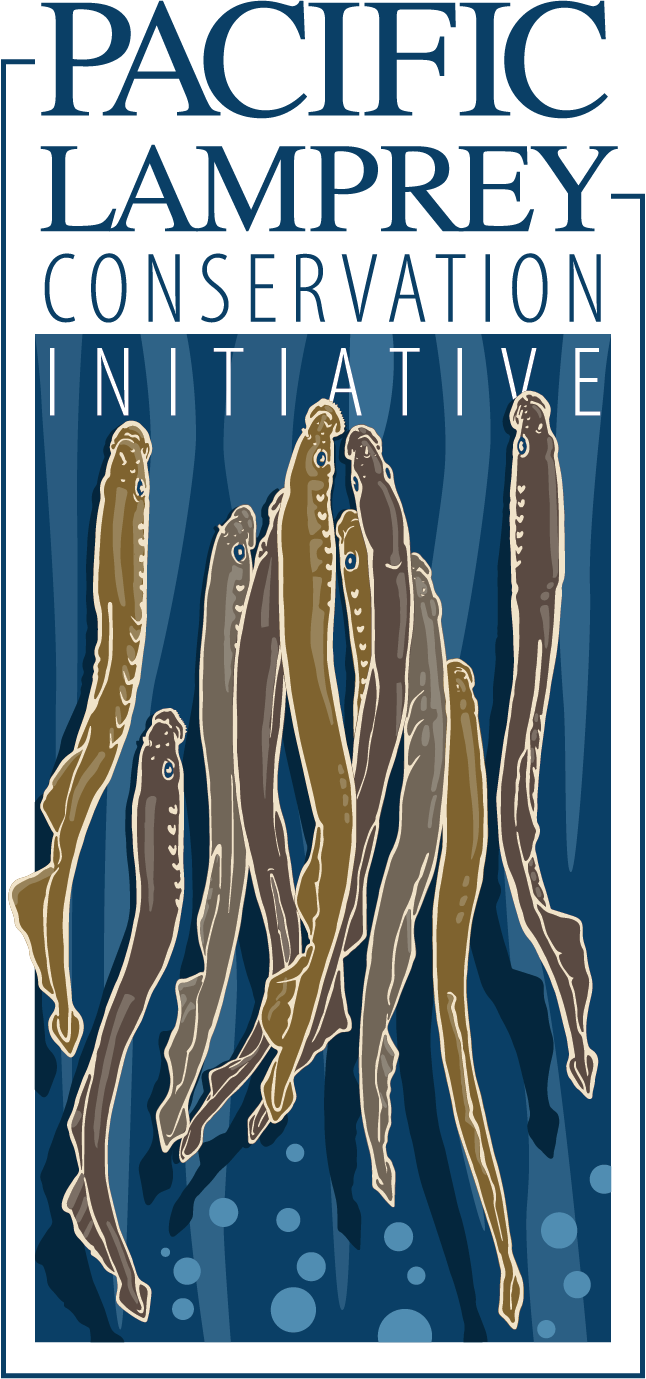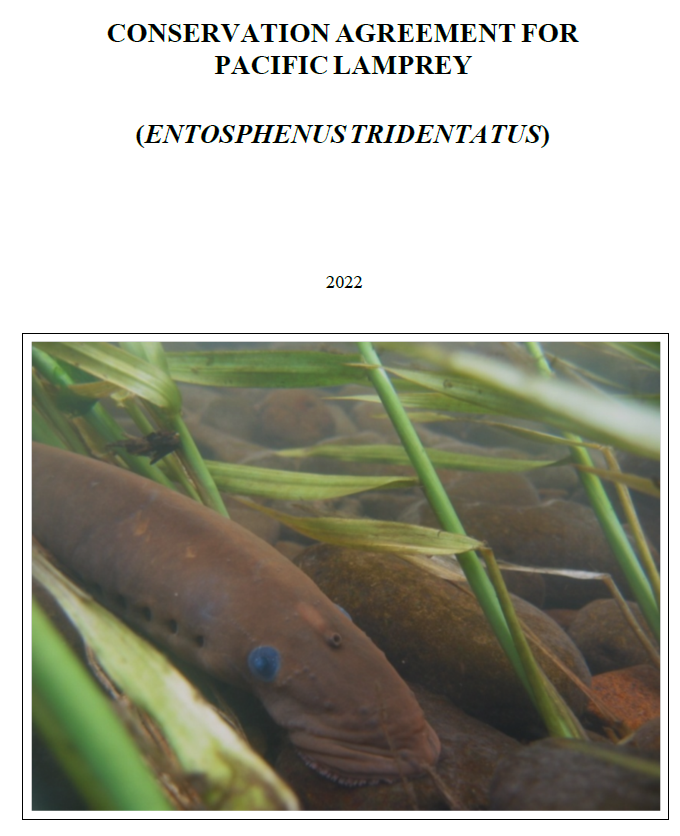Conservation Agreement
Conservation Agreement
The Pacific Lamprey Conservation Agreement (2022) represents a cooperative commitment by natural resource agencies and tribes to leverage available resources (human and capital) to reduce threats to Pacific Lamprey in the face of climate change, and to improve their habitats and population status, and support traditional tribal use of lamprey.
Since 2004, when a petition to protect Pacific Lamprey under the Endangered Species Act (ESA) was deemed unwarranted by the U.S. Fish and Wildlife Service (USFWS), a call to action was made by tribal partners to recognize the decline of the species. The Pacific Lamprey Conservation Initiative (PLCI) was initiated at Lamprey Summit II in 2008 by USFWS, and embodies this effort as a consortium of tribal, federal, state, local, and non-profit partners collaborating with a shared mission to address the decline of Pacific Lamprey across its historical range. This collaboration was solidified at Lamprey Summit III (2012) when the first iteration of the Conservation Agreement was signed by 33 signatories and 12 supporters.
Updates & Recommitments
The Conservation Agreement is revisited every five years for recommitment and revision if necessary. Modifications to the Conservation Agreement must be mutually agreed upon by all signatories, and all changes shall be executed in writing as an addendum to the original Agreement. The Conservation Agreement was not revised in 2017, but new supporters did formalize their commitment to the conservation of Pacific Lamprey by adding their signatures to the document, reflected in the Addendum.
2022 Update
In 2022, PLCI’s Conservation Team revised and updated the Conservation Agreement to reflect structural and operational changes within PLCI, as well as current status and progress made by PLCI and our partners in support of lamprey conservation over the last decade. Because changes were made to the Conservation Agreement, all supporting parties were asked to sign the 2022 Conservation Agreement again to become or maintain status as a signatory. If your organization would like to become a signatory, please contact PLCI’s Coordinator.
2022 Conservation Agreement Supporting Documents
Interim Operating Guidelines
The Interim Operating Guidelines (2015) help facilitate funding decisions for priority, unfunded lamprey actions. Guidelines processes are comprised of four basic parts:
- Regional Management Units (RMUs) develop and periodically update a list of potential restoration or research, monitoring, and evaluation actions;
- RMUs develop and periodically update Regional Implementation Plans (RIPs) that advance priority actions and provide a clear, but concise rational for their implementation;
- The Conservation Team evaluates RIPs to ensure implementation proceeds coordination and consultation among all affected and relevant parties, and;
- The Conservation Team provides the RMU recommendations to the Policy Committee to support identification and development of the necessary funding to implement these actions.
The Interim Operating Guidelines were drafted in 2015, and PLCI will update them as needed.
Signatories and Supporters of the
2022 Conservation Agreement
Signatories
- Blue Lake Rancheria Tribe
- Bonneville Power Administration (BPA)
- California Department of Fish and Wildlife (CDFW)
- Confederated Tribes of Grand Ronde
- Confederated Tribes of Siletz Indians
- Confederated Tribes of the Colville Reservation
- Cow Creek Band of Umpqua Tribe of Indians
- Idaho Department of Fish and Game
- Lower Columbia River Estuary Partnership
- Methow Salmon Recovery Foundation
- Mid-Columbia Fisheries Enhancement Group
- NOAA – National Marine Fisheries Service (NMFS)
- North Sound Trout Unlimited
- Oregon Department of Fish and Wildlife (ODFW)
- Oregon Water Enhancement Board (OWEB)
- Pacific States Marine Fish Commission (PSMFC)
- Portland General Electric (PGE)
- Portland Metro
- Snoqualmie Tribe
- U.S. Army Corps of Engineers (ACOE, USACE) – Northwestern Division
- U.S. Bureau of Indian Affairs (BIA) – Northwest Region
- U.S. Bureau of Land Management (BLM) – Idaho
- U.S. Bureau of Land Management (BLM) – Oregon/Washington
- U.S. Bureau of Reclamation (BOR) – Columbia-Pacific Northwest Region
- U.S. Fish and Wildlife Service (FWS) – Region 7 (AK)
- U.S. Fish and Wildlife Service (FWS) – Region 1 (WA/OR)
- U.S. Fish and Wildlife Service (FWS) – Region 8 (CA/NV)
- U.S. Forest Service (USFS) – Region 10 (AK)
- U.S. Forest Service (USFS) – Region 1 (Northern)
- U.S. Forest Service (USFS) – Region 4 (Intermountain)
- U.S. Forest Service (USFS) – Region 5 (PSW)
- U.S. Forest Service (USFS) – Region 6 (PNW)
- U.S. Geological Survey (USGS)
- Washington Department of Ecology – Office of Columbia River
- Washington Department of Fish and Wildlife (WDFW)
- Washington Department of Natural Resources (WA DNR)
- Yakima Basin Fish and Wildlife Recovery Board (YBFWRB)
- Yurok Tribe
Letters of Support
- California Department of Water Resources (CDWR)
- City of Bellingham
- City of Portland Environmental Services
- Clackamas River Basin Council
- Columbia River Inter-Tribal Fish Commission (CRITFC)
- Confederated Tribes and Bands of the Yakama Nation
- Confederated Tribes of the Umatilla Indian Reservation
- Department of Fisheries and Oceans Canada (DFO)
- Douglas County PUD
- Grant County PUD
- Lower Columbia Fish Recovery Board
- Nestucca, Neskowin, and Sand Lake Watersheds Council
- Oregon Water Resources Department (OWRD)
- Upper Columbia Salmon Recovery Board
- Washington Council of Trout Unlimited
- Washington State Department of Transportation (WSDOT)
©2022 Pacific Lamprey Conservation Initiative

